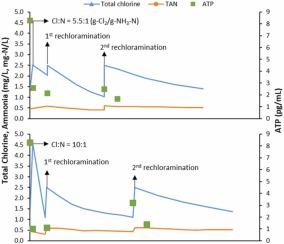Process Safety and Environmental Protection ( IF 6.9 ) Pub Date : 2022-07-27 , DOI: 10.1016/j.psep.2022.07.050 N.B. Karthik , K.C. Bal Krishna , Stuart J. Khan , Arumugam Sathasivan

|
A better alternative to breakpoint chlorination (BPC) or “chlorine burn” to recover from nitrification is proposed. The BPC involves adding chlorine to achieve Cl/N mass ratios more than 7.5 g-Cl2/g-NH4+-N to convert to free chlorinated system. Thus, it is operationally complex and increases the chance of the formation of regulated disinfection by-products (DBPs). Reverting the system back to (mono)chloraminated system is also operationally complex. All these processes require informing public and disruption to service. We tested three Cl/N mass ratios (5.5:1, 7.5:1, 10:1) and three predetermined reaction times (breakpoint reaction time). After the breakpoint reaction time, the samples were rechloraminated (2.5 mg/L at a Cl/N mass ratio of 4.5:1) twice. The second rechloramination was carried out when chloramine had reached 1.0 mg/L. The improvement was evaluated based on the ability of the method to improve chloramine stability, suppress nitrification, and reduce active bacterial cells. Results showed a Cl/N ratio of 5.5:1 (a new method) followed by two rechloramination doses achieved the same improvement as the traditional Cl/N ratio of 10:1 and one rechloramination. Major factor controlling the effectiveness of the new method relies on the ability of the disinfectant to deactivate chloramine-decaying proteins present in nitrified water. The new method does not need the conversion to a free chlorinated system and thus significantly minimises the operational complexity, disruption to service and potential to form DBPs. It offers a potentially novel solution but needs optimisation and testing in a continuous flow system.
中文翻译:

一种无“氯烧”的硝化水氯胺回收新方法
提出了一种更好的替代断点氯化 (BPC) 或“氯燃烧”从硝化中恢复的方法。BPC 涉及添加氯以使 Cl/N 质量比超过 7.5 g-Cl 2 /g-NH 4 +-N 转化为游离氯化系统。因此,它在操作上很复杂,并增加了形成受管制消毒副产物 (DBP) 的机会。将系统恢复为(单)氯胺系统在操作上也很复杂。所有这些过程都需要通知公众并中断服务。我们测试了三个 Cl/N 质量比(5.5:1、7.5:1、10:1)和三个预定反应时间(断点反应时间)。在断点反应时间之后,将样品再氯胺化(2.5 mg/L,Cl/N 质量比为 4.5:1)两次。第二次再氯化时进行氯胺已达到 1.0 mg/L。基于该方法提高氯胺稳定性、抑制硝化作用和减少活性细菌细胞的能力来评估改进。结果表明,Cl/N 比为 5.5:1(一种新方法),然后进行两次再氯化,与传统的 Cl/N 比为 10:1 和一次再氯胺化取得了相同的改善。控制新方法有效性的主要因素取决于消毒剂使硝化水中存在的氯胺衰变蛋白失活的能力。新方法不需要转换为游离氯化系统,因此显着降低了操作复杂性、服务中断和形成 DBP 的可能性。它提供了一种潜在的新颖解决方案,但需要在连续流动系统中进行优化和测试。











































 京公网安备 11010802027423号
京公网安备 11010802027423号